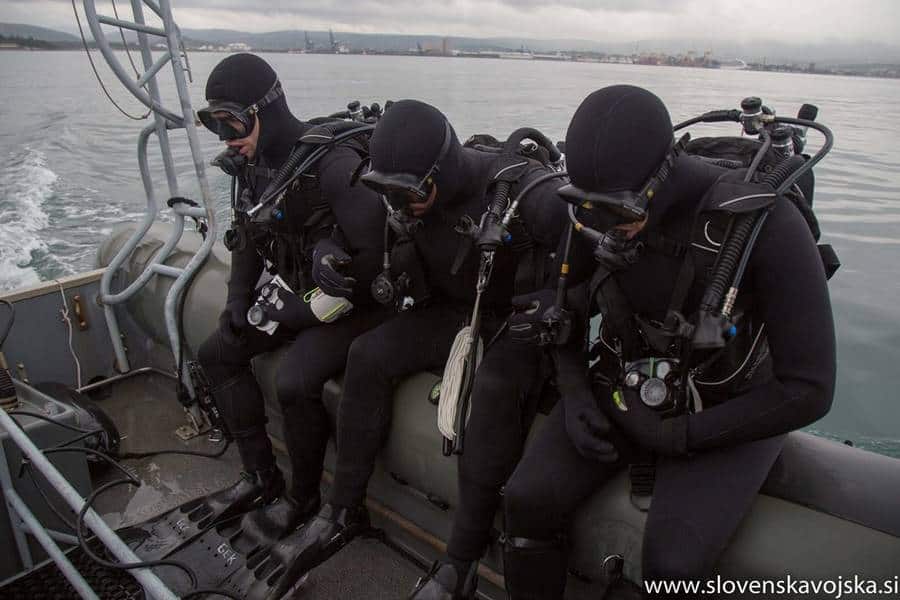A new generation of long range, long endurance autonomous underwater vehicles (AUVs) able to travel from port to port is emerging – with the support of Sonardyne acoustic and optical systems. Ioseba Tena, Global Business Manager for Defence and Robotics, takes a look at one.
The concept of a long range autonomous or unmanned underwater vehicle (UUV) able to travel long distances and quietly and covertly hover in strategic locations is a desired and useful capability in today’s world.
In the defence sector, it would enable increased and extended military surveillance and support anti-submarine warfare (ASW) operations. In the commercial world, a long range AUV that can travel from port, carry out a full route survey and then return home again – without intervention – would eliminate the need for costly and risky launch and recovery operations at sea using ships.
With help from our underwater acoustic and optical positioning and communications systems, steps towards realising this capability are now being taken by Canadian underwater systems specialist Cellula Robotics.
Under a programme for the Canadian Department of National Defence’s (DND) science and technology organization, Defence Research and Development Canada (DRDC), Cellula has designed and built a 8.5 m-long, 1 m-diameter, 3,000 m depth-rated vehicle that’s able to carry-out multi-month, long endurance underwater surveillance over a 2,000 km range. It’s called the Solus-LR (Long Range).
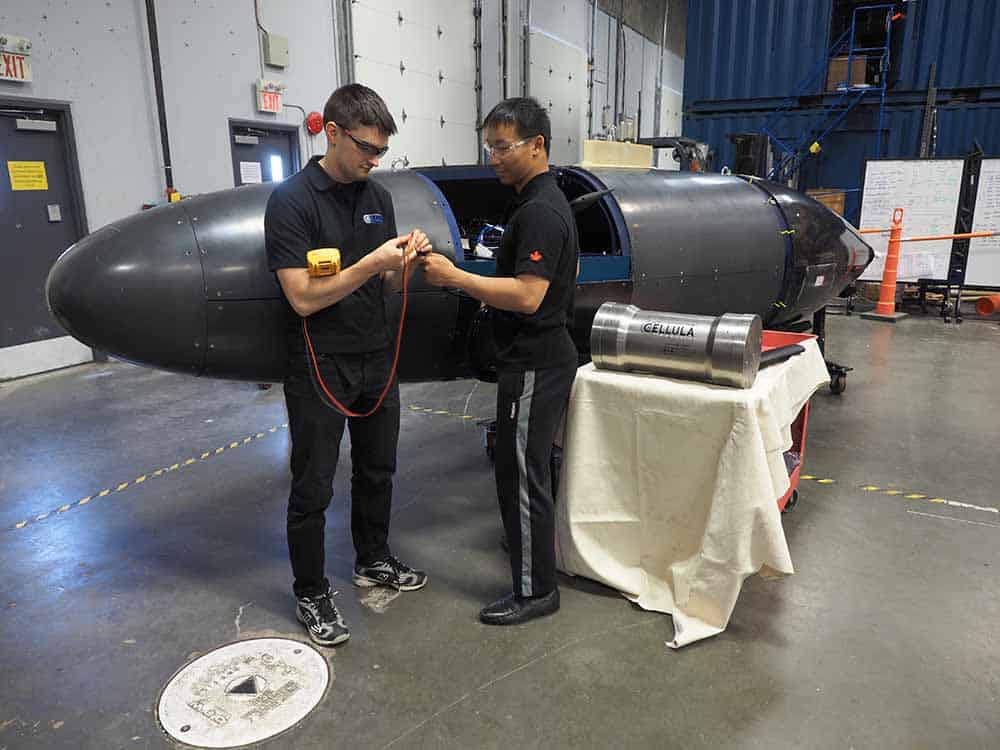
The Solus Long Range (LR)
The UUV, which is due to begin sea trials this October, brings together a unique payload configuration innovative onboard power system and integrated navigation and communications suite, in order to meet the DRDC’s All Domain Situational Awareness (ADSA) Science & Technology (S&T) Program objectives, which include enhancing domain awareness of air, maritime surface and sub-surface approaches to Canada, in particular those in the Arctic.
To start with, long-endurance mission capability is being enabled by a new-design high-pressure hydrogen and oxygen fuel cell, delivering 250 kWh of usable energy. But its other secret weapon is a specially designed suction anchoring system, which, deployed via the UUV’s underhull cargo doors, allows the vehicle to tether itself to the seabed in a low-power loiter mode, quietly and covertly listening for a range of targets.
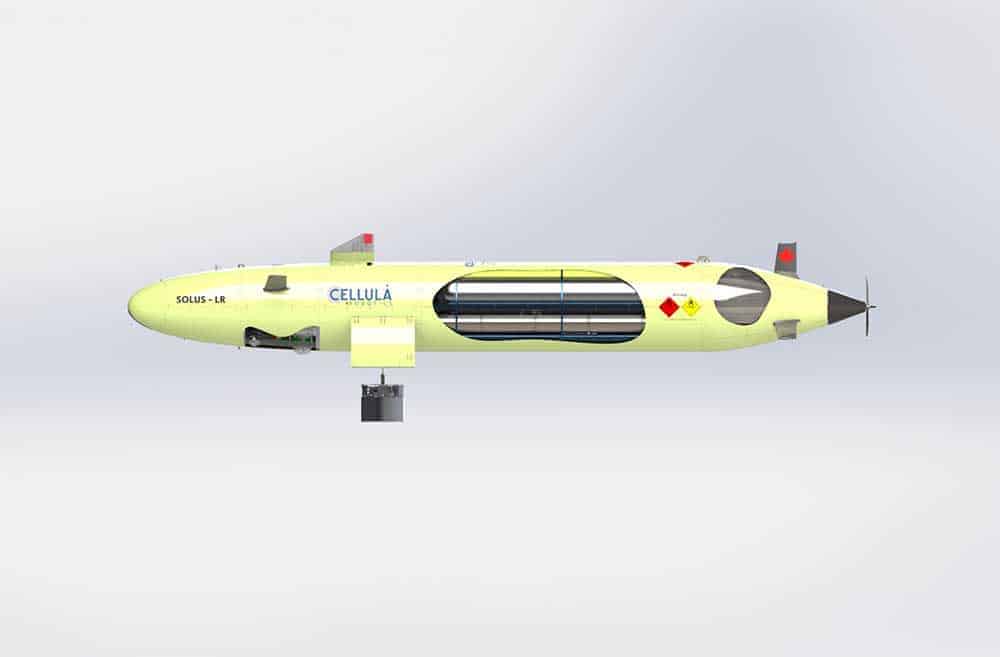
Sonardyne for guidance and communications
Underpinning its guidance and communications – the backbone of any long-duration underwater vehicle – is a suite of our trusted 6G positioning and communications acoustics and high speed optical modems. Critically, to aid the Solus-LR on its multi-month missions, Cellula has integrated our SPRINT-Nav hybrid (Doppler and inertial) navigation instrument. SPRINT-Nav is already proving its worth on deep water autonomous underwater vehicles (AUVs) and remote operated vehicles (ROVs) globally and this is just the latest testament to the performance it offers.
Its high performance is crucial to enabling prolonged autonomy over long ranges. By limiting error growth through dead-reckoning, SPRINT-Nav enables underwater vehicles to travel for longer without surface support. The alternative – i.e. poor navigation performance – would limit the autonomy of the vehicle and therefore its usefulness.
For Cellula, SPRINT-Nav offers not only a high-performance, operationally proven instrument, but also one which is easy to upgrade, thanks to the availability of different grades of Honeywell-engineered ring laser gyros (RLGs) to support different mission performance levels – all packaged in the same form factor.
Endurance trials
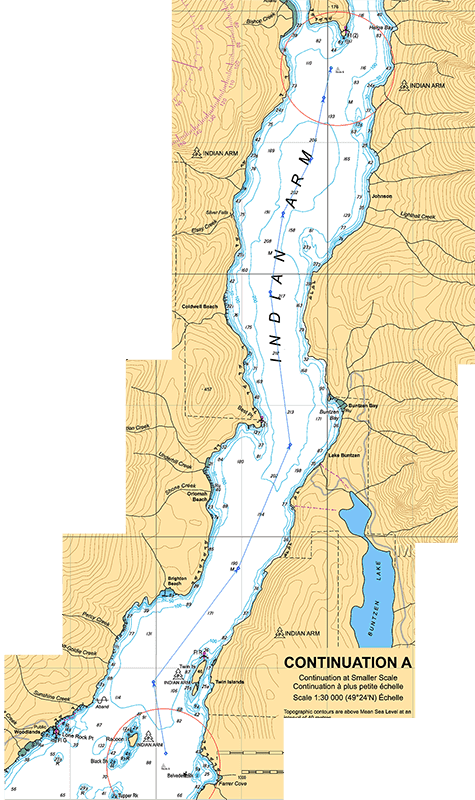 Sea trials start in Indian Arm fjord, near Vancouver, British Columbia this autumn – just 18 months after the project was kicked off. The trial itself will be equally ambitious – requiring Cellula’s Solus-LR to run 10 km laps of a range in the fjord, without surface support for about a month.
Sea trials start in Indian Arm fjord, near Vancouver, British Columbia this autumn – just 18 months after the project was kicked off. The trial itself will be equally ambitious – requiring Cellula’s Solus-LR to run 10 km laps of a range in the fjord, without surface support for about a month.
Integrating trusted, commercial-of-the-shelf technologies (COTS) like our acoustic, inertial and free-space optical sensors into underwater capability programmes – especially naval ones – has considerable appeal. It reduces cost, reduces risk and crucially means that the time needed for new platforms to enter service can be measured in months not years.
The trial will be supported with Compatt 6 seabed transponders, BlueComm 200 optical modems and our Micro-Ranger 2 Ultra-Short BaseLine (USBL) acoustic tracking system with bolt-on Robotics Pack. This will be used for tracking, telemetry and control, supported by an AvTrak 6 Omni-directional combined transponder, transceiver and telemetry instrument, integrated into Cellula’s UUV.
“At the north end of the range, a Compatt 6 will be deployed and surveyed to provide a navigation update to the SPRINT-Nav,” says Cellula’s Business Development Manager, Adrian Woodroffe. “Meanwhile, the south marker will have a Micro-Ranger 2 installed on a surface buoy for acoustic telemetry and position updates and Sonardyne’s BlueComm subsea optical modem installed on a seafloor lander connected to the buoy. The surface buoy will have a cellular data link providing a communication link back to our office.”
Long range and autonomous
“During the demonstration mission, Solus-LR will operate submerged and truly autonomously without a chase boat. Solus-LR will check in with us approximately every six hours as it passes the south marker, with low bandwidth status updates via an acoustic link using the AvTrak 6 on the AUV and the Micro-Ranger 2 on the buoy. Here, it can also receive mission updates and transfer large log files using the high bandwidth BlueComm link. At the North end of the range, the SPRINT-Nav will autonomously use the seafloor Compatt 6 to reduce the INS drift and correct any accumulated position error since the last update.”
Throughout, our application engineering team will be on hand, ready to help. So, Cellula is not only supported by the full range of instruments it needs for the Solus-LR – all from under one roof – but also the engineering support it needs to get the best value from its instruments and us.
We look forward to supporting the trials and seeing the Solus-LR take the next step. The end result could offer new capabilities for defence, survey and monitoring applications, all Sonardyne supported. Get in touch if we can help you achieve your subsea long range autonomous vehicle goals.
International subsea services provider DOF Subsea has equipped a further three of its Brazilian offshore vessel fleet with hybrid acoustic and inertial navigation technology from Sonardyne Brasil Ltda.
Sonardyne’s SPRINT-Nav all-in-one subsea navigation instruments are now supporting five Forum Energy Technologies (FET) remotely operated vehicles (ROV) on board the three vessels. This latest order takes the total number of DOF Subsea’s Brazilian vessels equipped with SPRINT-Nav aided ROVs to six.
SPRINT-Nav combines Sonardyne’s SPRINT sensor, Syrinx 600 kHz DVL (Doppler velocity log) and a high accuracy intelligent pressure sensor in a single housing, making it one of the smallest combined acoustic-inertial navigation instruments on the market. The system is fast becoming the instrument of choice for underwater vehicles, both meeting stringent specifications for subsea inertial navigation and providing industry-leading high-performance positioning – all from a single tightly integrated instrument.
DOF Subsea’s growing fleet of SPRINT-Nav systems will be used to support the company’s ROV operations, as part of construction, inspection, maintenance and repair (IMR) work in Brazil’s deepwater pre-salt oil fields, in depths down to 3,000 m.
[blockquote author=” Fábio Nóbrega, Survey Manager at DOF”]”Having adopted SPRINT-Navs for three of our vessels earlier this year, we’re seeing clear benefits. Not only do we now have high -performance hybrid acoustic aided INS positioning for our underwater vehicles, we also benefit from Sonardyne Brasil Ltda.’s support here in Brazil, from training to support during installation and commissioning, all by local specialised field engineers. Choosing these instruments for our vehicles, underpinned by the support we receive, helps us to provide the excellence our customers require for their deepwater operations here, offshore Brazil.”[/blockquote]
Speaking about the contract, Andre Moura, Sales & Applications Manager for Sonardyne in Brazil said: “It is a great pleasure for us, now being present on six of DOF Subsea’s ROV support vessels in Brazil. This latest batch, which are already installed, is a testament to the relationship we have with our customers here in Brazil, where consistency of local support and collaboration is central to our working ethos.”
This year, Sonardyne is celebrating its 20th anniversary in Brazil, having first set up an office in the country in 1999. Within the last year alone, the company has now supplied nine Brazil based vessels with its acoustic positioning and navigation technologies, from high performance Ultra-Short BaseLine (USBL) systems to its latest hybrid navigation technology.
BP’s first foray into unmanned over-the-horizon operations, using Sonardyne technology and an unmanned surface vessel (USV), is helping it gather strategic data. It’s also a key step towards a more marine autonomous systems led future. Craig Allinson, Survey and Positioning Lead at BP North Sea, explains.
Throughout the life of a field, reservoir management strategies can change and, when they do, we need data to verify what impact we’re having. For the Machar field in the North Sea we changed our reservoir water injection strategy and we wanted to monitor its impact.
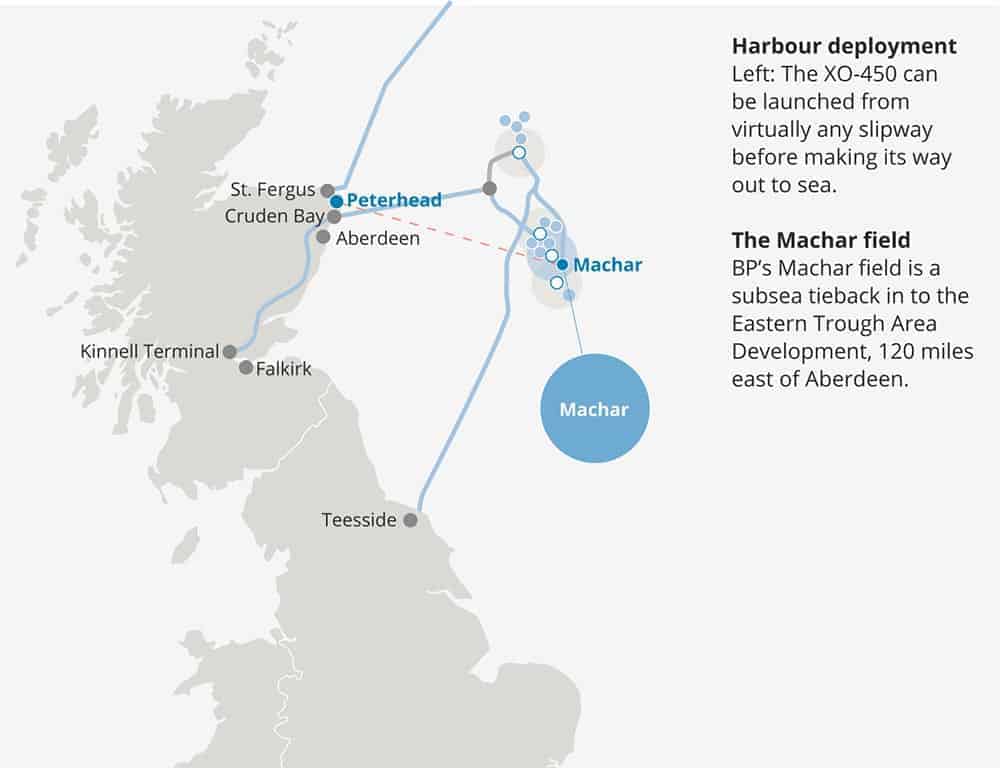
Specifically, we wanted an efficient way to keep a close eye on any seabed deformation in the field. Having considered unmanned operations for some time, we decided, in a first for BP, to use seafloor sensors combined with an unmanned surface vessel (USV), operated over the horizon, for data harvesting. We chose XOCEAN’s XO-450 USV (visit stand 1B57), fitted with a Sonardyne Mini-Ranger 2 6G Ultra-Short BaseLine (USBL) system. The Mini-Ranger 2 has modem functionality, so it can communicate with and retrieve data from Fetch low-power, long-life subsea sensor logging nodes, also from Sonardyne, that were chosen for our seabed deformation monitoring.
Using a USV for unmanned monitoring
The XO-450 is an International Marine Organisation (IMO) compliant, 4.5 m-long USV with a hybrid power system, including a diesel generator and solar panels, powering lithium-ion batteries to drive the electric thrusters and all instrumentation. The vessel has an 18-day endurance capability with communications (including dual redundant satellite communications systems), cameras (including thermal imaging) and navigation lights. It’s able to communicate real time with XOCEAN’s onshore control room, where pilots have a full view of all the systems and can take control at any time, 24/7, so we can use the vessel almost anywhere.
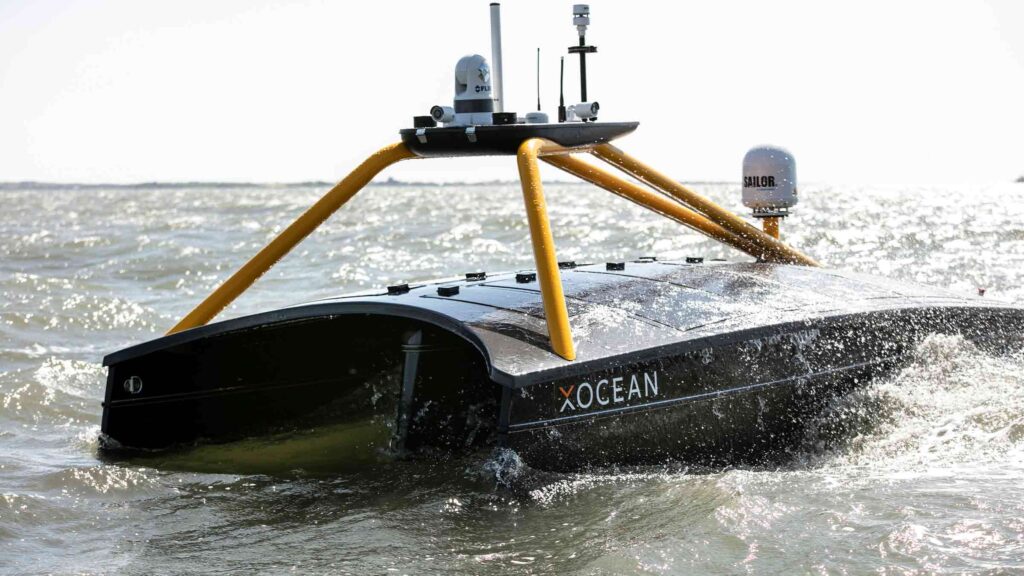
Sensor deployment and data retrieval
The project started in November 2018, when we installed four Fetch sensors over the Machar field. After a few months, we wanted to go out and harvest the data they had collected. So, in early April, the XO-450 was brought by trailer to Peterhead, Scotland, where it was launched from a slipway. The USV used waypoints to safely transit 120 miles out to Machar. Once on site, we located and then started communicating with each Fetch sensor, first to check its health and then to download its data, while the USV held its position, auto-piloting in a 25-30 m radius to let the Mini-Ranger 2 do its work.
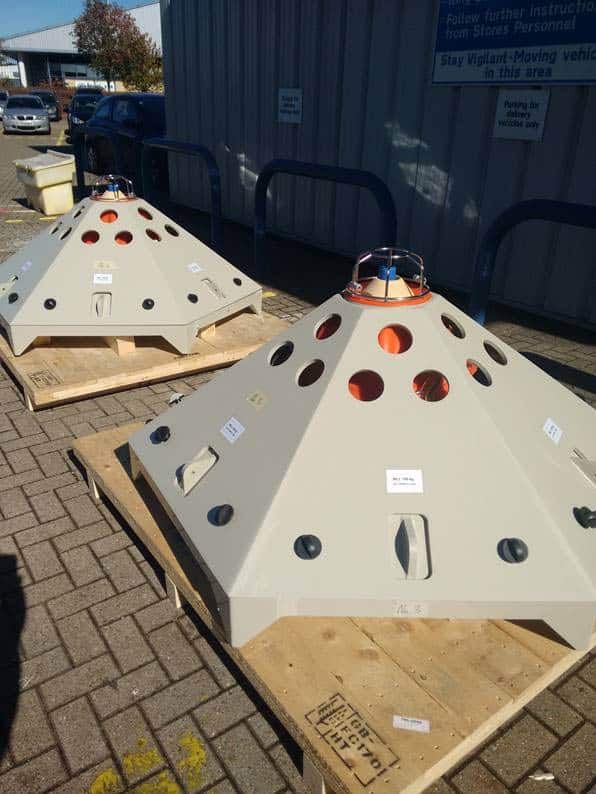
After each download, the USV’s satellite communications sent the data to shore, where we confirmed, in real time, that we had the data we needed before moving on to the next Fetch. Throughout these operations, Sonardyne specialists were on hand (remotely) with full access to the XOCEAN real-time data to ensure the harvesting was successful and completed efficiently. When the operation was complete, the vessel transited safely back to Peterhead for demobilisation – within 40 hours of having set off.
Enabling SIMOPS
No project is that smooth of course. We had to wait for a suitable 5-day working weather window for the operation. It came during Ocean Business in Southampton, where the XO-450 was on show. With only a few hours’ notice, XOCEAN were able to drive the vessel up to Peterhead for mobilisation within 24 hours.
Once offshore, there was a light well intervention (LWI) vessel operating close to one of our sensors, which meant we had to negotiate going into their 500 m exclusion zone and perform simultaneous operations (SIMOPS). There was also a concern that the acoustics being used from the LWI vessel and ours – which were using the same frequency – could interfere with each other. So, we took a risk-based approach and started our data collection campaign from the Fetch that was furthest from the LWI vessel, keeping in continuous contact with its crew. There was no interference. We then got within 100 m of the LWIV to access to sensor closest to it and successfully harvested the data without any problems; a SIMOPS success. Had we not been using the USV we would not have been able to get as close to the fetch unit, because it was within the LWI vessel’s 500 m zone, and data harvesting of this unit may not have been possible.
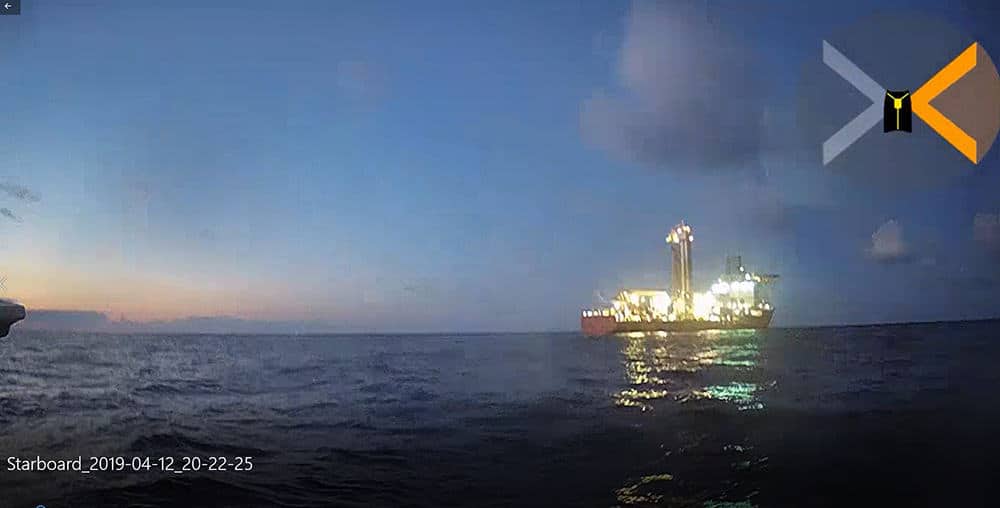
Reducing HSE and emissions
A key reason for us going down this route, for using a USV over the horizon, was to eliminate health, safety and environmental (HSE) risk. Unmanned operations with a small vessel enable us to do that. They achieve a significant reduction in carbon emissions – compared with a manned vessel – and total elimination of the need for humans offshore for this type of work. We also get a significant cost saving, compared with using a conventional vessel.
BP have been pleased with the result of this operation and we have proven the concept of data harvesting with USV. We now have our data from the first harvest and the results are being assessed. The Fetch units are continuing to monitor the seabed at Machar, which will enable us to continue monitoring the seabed, harvesting data twice a year, using the USV, for some years to come.
Underwater navigation technology from Sonardyne International Ltd. has been chosen by subsea equipment specialist Soil Machine Dynamics Ltd. (SMD) for its new electric work class remotely operated vehicle (ROV) range, launched today at Offshore Europe in Aberdeen.
The Quantum EV will be factory-fitted with Sonardyne’s hybrid navigation solution, Lodestar-Nav 200, as standard, enabling new owners to put the ROV straight into operational service after taking delivery.
 The Quantum EV Work Class ROV prototype introduces electric drive technology to the subsea sector in an optimised, modular package which brings electric ROV performance and capability to a new level. Lodestar-Nav is a turnkey navigation solution for ROV control and guidance. It combines a high accuracy attitude heading reference system (AHRS), Syrinx Doppler velocity log (DVL) and survey grade pressure sensor, in an all-in-one instrument, making it less complex to integrate and operate. What’s more, Lodestar-Nav is pre-calibrated providing the ROV pilots with a robust and reliable solution, even in the most challenging operational scenarios, without needing to worry about sensor offsets.
The Quantum EV Work Class ROV prototype introduces electric drive technology to the subsea sector in an optimised, modular package which brings electric ROV performance and capability to a new level. Lodestar-Nav is a turnkey navigation solution for ROV control and guidance. It combines a high accuracy attitude heading reference system (AHRS), Syrinx Doppler velocity log (DVL) and survey grade pressure sensor, in an all-in-one instrument, making it less complex to integrate and operate. What’s more, Lodestar-Nav is pre-calibrated providing the ROV pilots with a robust and reliable solution, even in the most challenging operational scenarios, without needing to worry about sensor offsets.
For complex survey applications, where an inertial output is required, Lodestar-Nav can easily be remotely upgraded in the field to a SPRINT-Nav, Sonardyne’s increasingly popular acoustic-inertial hybrid navigation system.
[blockquote author=” Mark Collins, Director for Remote and Autonomous Solutions, SMD “]”The EV range represents a new philosophy in ROV design focused on performance, reliability, flexibility, ease of use and compact form factor. It makes sense to apply the approach to the sensors we select to fit. Lodestar-Nav exceeds our stringent design criteria and focus on ease of use and reliability. Over the past few months our engineering team has been working closely with Sonardyne’s to fully understand the instrument’s impressive capabilities and complete all the integration and pre-delivery testing regimes.”[/blockquote]
Alan MacDonald, Sales Manager with Sonardyne in Aberdeen, says, “Lodestar-Nav’s 4,000 metre housing is compact and easy to fit with just one cable to interface so fitting it during the build of a vehicle makes a lot of sense. From an end-users’ perspective, taking delivery of your new vehicle with the navigation already taken care is very appealing, and means you can put your new asset to work in less time.”
Underwater maritime security specialist Sonardyne Inc. will present its advanced unmanned underwater vehicle (UUV) tracking results at the Advanced Naval Technology Exercise (ANTX) this week in Newport, Rhode Island.
The event’s attendees will be shown the results of recent trials which tested Sonardyne’s Sentinel Intruder Detection Sonar (IDS) against elite US Navy divers and small UUVs. Specifically, the strength of Sentinel IDS’ combined active and passive intruder detection sonar for ship and harbour security, against even the smallest UUVs, will be demonstrated.
Sentinel is the undisputed leader in the IDS field. Since its introduction, it has been used in critical national infrastructure (CNI), vessel and VIP protection duties around the world. Sentinel IDS detects, tracks and classifies a wide range of threats including divers, swimmer delivery vehicles (SDVs) and UUVs, when approaching a protected asset from any direction. It then alerts security personnel to the threat.
ANTX has become a key naval technology collaboration, development and demonstration event in the US calendar, bringing together more than 1,000 naval, academic and industry attendees at the US Naval Undersea Warfare Center’s (NUWC) Narragansett Bay Test Facility (NBTF) in Newport. The NBTF is a test and evaluation facility designed to support research and development work in advanced underwater weapons and weapons systems, weapon launchers, UUVs and oceanographic equipment.
Ahead of the event, Sonardyne collaborated with the BAE Systems’ UUV team and navy divers to test its Sentinel IDS system.
Dan Zatezalo, Technical Sales Manager, manager – US Maritime and Defense – Sonardyne “ANTX is a great event for collaboration. Not only have we had US Navy divers swimming against our Sentinel IDS system, but also BAE Systems put its Riptide vehicle in the water. This let us collect some really good data which we have already used to further improve our Sentinel algorithms for detecting UUVs.”
“This year’s theme at ANTX is ‘Prepare for Battle: Undersea Security’ and that’s exactly what we offer. We have the tools for navies, defence and security organisations to do just that. With the ability to detect targets at ranges of up to 1,500 m, Sentinel takes reliable, long-range underwater intruder detection to a new level.”
The ANTX opening ceremony is tomorrow (Wednesday, August 28) with the ANTX Exercises run throughout Thursday (August 29).
Intruder detection sonar (IDS) are a key tool in maritime security operations, even in peacetime. But, while you hope that you will never hear it sounding the alarm that you have an intruder, putting it to the test – during peaceful exercises – does offer comfort that it will perform when you need it.
That’s just what the Slovenian Armed Forces (SAF) 430th Naval Division has been doing recently. As part of a broader multinational exercise, their Underwater Special Operations Detachment carried out operations alongside a group of divers from the Montenegrin Navy – a perfect opportunity for putting Sentinel to the test.
But first, a little fact for you. Largely landlocked, Slovenia has a lot of borders to protect. While it’s a relatively small country, it has many neighbours, from Italy, in the west, to Austria, in the north, Hungary in the east, and Croatia, to the south.
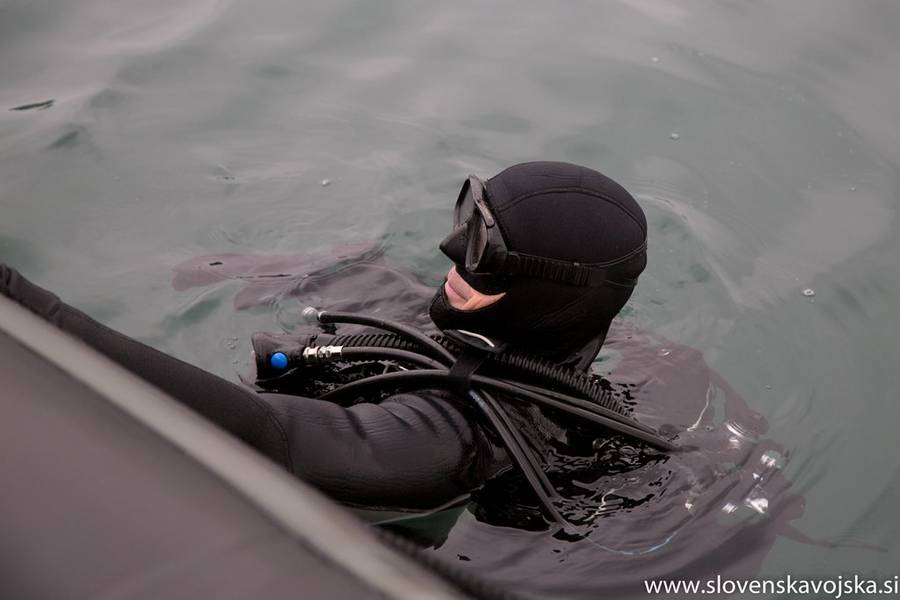 It’s also got a short, but important, stretch of coastline at the north end of the Adriatic Sea. While peaceful now, this area has been strategic since pre-Roman times. It’s been under Roman, Croatian, Habsburg, Ottoman and Napoleonic rule, to name a few.
It’s also got a short, but important, stretch of coastline at the north end of the Adriatic Sea. While peaceful now, this area has been strategic since pre-Roman times. It’s been under Roman, Croatian, Habsburg, Ottoman and Napoleonic rule, to name a few.
So, Slovenia doesn’t have a navy. Instead, its army has the 430th Naval Division to protect its short section of coastline, including the port town of Koper.
But, back to the exercises. They were extensive. Starting with integration drills, involving underwater and surface inspection of the operational area, they moved on to joint inspection of navigable waterways, and then a mine hunting and detection exercise around moorings used by allied vessels.
Throughout, the underwater part of the port’s disembarkation area – which is protected by the 430th Naval Division – was monitored using Sentinel, which is able to detect divers, swimmer delivery vehicles (SDV) and autonomous underwater vehicles (AUVs) in the water. It was then used to steer the force reaction towards the simulated intruders.
Meanwhile, crews on a multi-purpose patrol boat, the Triglav, and a fast-patrol boat, the Ankaran, patrolled the Slovenian territorial sea, to provide broader protection.
For armies and navies, exercises with allies to train in command and control procedures, as well as various tactical procedures at sea, are a great opportunity to maintain or raise their competence and readiness.
It’s also a great opportunity to test kit – like Sentinel. Sentinel is the undisputed leader in the IDS field. Sentinel detects, tracks and classifies a wide range of threats including divers, SDVs and AUVs, when approaching a protected asset from any direction. It then alerts security personnel to the threat. With the ability to identify targets at ranges of up to 1,500 m, Sentinel takes reliable, long-range underwater intruder detection to a new level. Since its introduction, has been used in critical national infrastructure, vessel and VIP protection duties around the world.
In Slovenia, the 430th Naval Division often use their Sentinel from vessels in port, while at anchor. For the multinational exercises, they deployed it from a pole mount from the patrol boat stern platform. It performed well, detecting divers at the ranges expected from Sentinel and a good detection percentage – which is always important. Too many false detections can reduce the effectiveness of any IDS.
The 430th Naval Division’s use of Sentinel shows its flexibility – it can be deployed and redeployed from different vessels, quaysides, subsea mount frames or even buoys. It’s compact, but it’s also scalable. We can network Sentinel sonar heads together to improve situational awareness. Sentinel merges the data from all the units and presents a single picture of the environment. Using simple interfaces, we can integrate it with third-party security systems or command and control (C2) stations.
There’s also a Sentinel expeditionary system configured for Portable Diver Detection Sonar (PDDS) duties. Its small topside footprint means it’s perfect for short-term operations using offshore patrol vessels (OPVs) and temporary sites on shore.
But don’t take our word for it. Those using it rely on it. For the 430th Naval Division it’s a key tool in its port protection. Or in their words: “We consider Sentinel a very reliable tool in our force protection set-up.”
By Steve Fairhead, Manufacturing apprenticeship programme lead
We value vocational skills and training – they under-pin everything we do. So we’re hugely proud of one of our apprentices, Tom Andrews, who is set to fly all the way to Kazan, Russia, this summer to represent not just Sonardyne, but the UK in the WorldSkills finals.
Tom is in his last year of a Foundation Degree in Engineering at Alton College while working with us. He is one of just 30 young professionals selected to compete for Team UK at the event, in the capital of Tatarstan, some 800 km east of Moscow.
His place on Team UK, representing the electronics discipline, follows two years of hard work getting through regional and national competitions and team selection events. In fact, earlier this summer he went to Kouvola in Finland, to join other competitors from Russia, Switzerland, Brazil, Singapore and Finland in pre-competition training.
[blockquote author=”Tom Andrews, Apprentice Engineer, Sonardyne “]“It’s already been a great experience,” he says, “Not only having the opportunity to travel to these places, but also to meet other young engineers like me and to develop workplace skills and really test and progress my electrical engineering know-how.”[/blockquote]
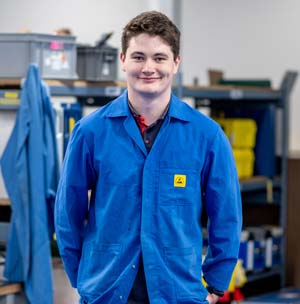
“Our training in Finland was about running through the types of challenges that will be thrown at us when we get to Kazan in a few weeks’ time. Because it wasn’t the final competition, we got to help each other, and we all enjoyed that interaction. The final will be different, of course, but it’s still going to be quite an experience. I’m looking forward to representing the UK!”
Representing the UK on the world stage is a great opportunity for Tom and us. We support skills training here at Sonardyne and this bi-annual competition, which has origins dating back to post-war Europe, couldn’t be a better way to showcase that.
A track record
In fact, we’ve been represented before. Now a junior engineer, Tua Yenwattana competed at WorldSkills in 2014. Tua studied electrical and electronics engineering at Basingstoke College of Technology and won apprentice of the year in his fourth year there. He’s now working in our engineering department, after starting as a repair apprentice, then moving into systems test. Dan Hinsley, another of our apprentices who is now a junior engineer, studied at Basingstoke College at the same time as Tua. Dan also won apprentice of the year – three years in a row!
Our apprentices today – Tom included – are working towards qualifications including Higher National Certificates (HNC), NVQ extended diplomas and foundation degrees at Basingstoke College, Farnborough College of Technology and Alton College.
Getting on the career ladder
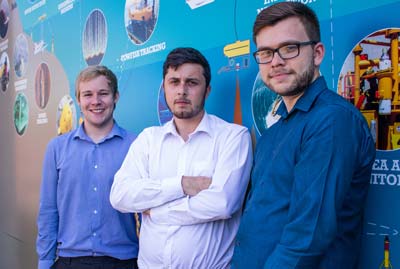
James Kinsey, Jimmy Page & Josh Hall
Taking an apprenticeship is a great first step on the career ladder. In fact, I was Sonardyne’s very first apprentice and now lead our manufacturing apprenticeship programme as well as running our repair department. I have two apprentices under my wings at the moment, Fraser Sanford and Howard Old, who are both working towards a HNC in electronics and a Level 3 NVQ extended diploma in electrical and electronic engineering. Once qualified, they will be starting their careers as repair technicians.
In our engineering team, last year saw three now former apprentices – James Kinsey, Jimmy Page and Josh Hall – graduate with First Class Bachelor degrees (with honours) in Embedded Electronics. They had studied for a Foundation Degree in engineering at Alton College before spending a year at the University of Portsmouth. Another three apprentices are now currently working on their Foundation Degrees.
Supporting engineering education
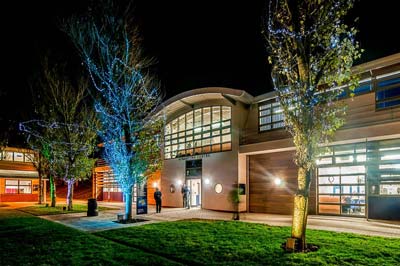
The Sonardyne Centre at Alton College
But as well as supporting our apprentices, we’re also proud of the support we offer to colleges and universities. For example, through The Sonardyne Foundation, we supported the building of Alton College with a substantial grant which enabled them to complete their engineering and design technology building, named the Sonardyne Centre when it opened in 2013.
Sonardyne has had a long relationship with Bristol University, where our founder John Partridge studied. We’ve helped to support the university’s schools outreach programme and equipped a new electrical teaching laboratory in the Faculty of Engineering.
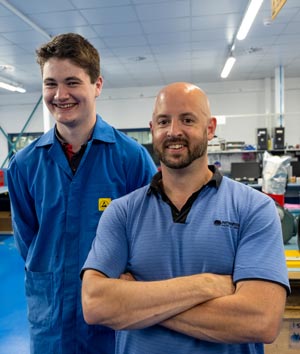
Tom and Steve
Most recently, we’ve pledged £20,000 to Newcastle University to help set up the Newcastle University Sonardyne Robotics and Autonomous Systems Student Laboratory. This will support student activities, from the school of engineering and beyond, on the design of underwater vehicles. We’ve also been supporting a three-year programme of Masterclasses in Engineering, Mathematics and Computer Science at the Royal Institution for children around the South East of England.
WorldSkills is a biennial event, dubbed the ‘Skills Olympics’. This year’s event is due to be held on August 22-27. Tom will join young professionals from more than 60 countries across the world competing in 56 disciplines, from sectors including engineering, hospitality, construction, IT and more.
The event will be broadcast live on TV and streamed around the world and we’ll be watching to see if Team UK can beat the 10th place that it achieved at the last WorldSkills finals in Abu Dhabi in 2017. We’ll also of course be rooting for Tom!
Australian headquartered subsea services specialist Neptune has become the latest company to adopt Sonardyne International Ltd.’s new, all-in-one acoustic and inertial positioning technology platform to support its offshore survey projects.
The order, made through Sonardyne’s Singapore subsidiary, includes the supply of Fusion 2 software, Compatt 6 seabed transponders and ROVNav 6 LBL (Long BaseLine) vehicle-mounted transceivers. The Compatt 6s and ROVNav 6s will be Sonardyne’s latest ‘plus’ hardware platform (6+), engineered to unlock the full capabilities of Fusion 2.
Built from the ground up, with ease of use and operational efficiency in mind, Fusion 2 software offers a seamless environment in which surveyors can perform all of their LBL, SPRINT INS (inertial navigation system) and sparse (INS-aided) LBL operations. When used alongside 6+ hardware, Fusion 2 offers the ability to simplify complex projects – all with less subsea and topside hardware.
As part of the deal, Neptune is trading-in its inventory of Compatt 5 seabed transponders which, after many years of reliable service, now date back to two generations of Sonardyne LBL subsea hardware. Their 6+ replacements are scheduled to go straight to work supporting Neptune’s upcoming rig positioning and field support campaigns in Asia and Australia.
[blockquote author=”Fournier, General Manager, Neptune”]“Sonardyne came to see us in Perth late last year, as part of their Fusion 2 and 6+ launch tour. The in-water demos they ran were impressive to say the least – particularly the display of combined data telemetry and range updates and real-time INS-aided LBL SLAM (simultaneous localisation and mapping) calibration. This new Sonardyne equipment will continue to allow Neptune to remain at the forefront of technology and demonstrates Neptune’s commitment to supply its clients with the latest subsea technology solutions.” [/blockquote]
Graeme Buchanan, Sales Manager with Sonardyne Asia Pte. in Singapore says, “Markets often need time to understand the reasons behind the introduction a generational change in a technology platform. But in the case of Fusion 2 and 6+, our customers have been very quick to appreciate how the all-in-one approach we’ve taken will transform and simplify their operations.
“Neptune is a long-standing customer of ours and we’re confident they will see the benefits of this purchase from the moment they start using it.”
Author: Graham Brown, Deputy Managing Director, Sonardyne
The recent surge of successful attacks on vessels transiting the Strait of Hormuz and the Gulf of Oman once again highlights the relative ease with which vessels at sea can be targeted.
As political tensions in the region continue to escalate, owners and operators of oil and LNG tankers are urgently rethinking how best to keep their crews and fleets safe and energy supplies flowing.
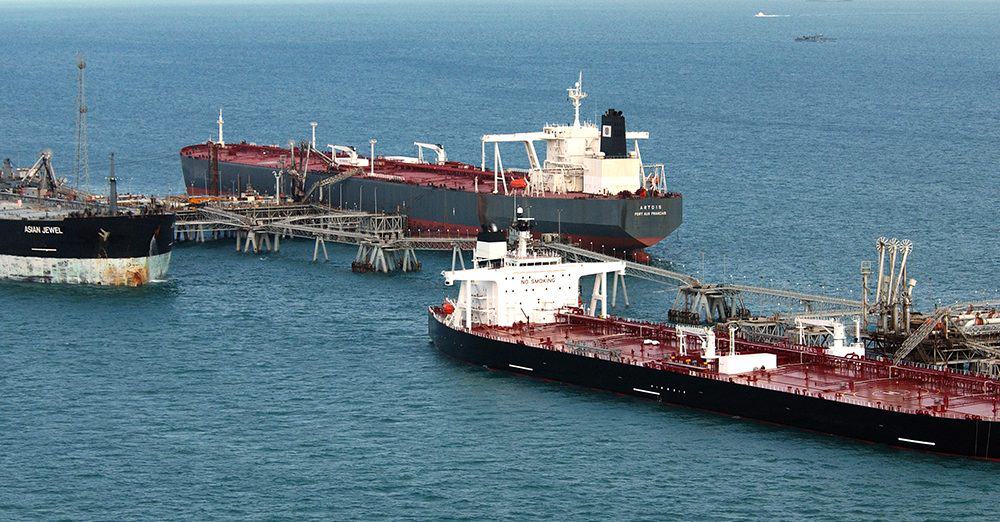
Measures such as radar and long range thermal cameras are effective at closing security gaps above the water – but what about under the water? What’s available to help security personnel spot submerged threats from reaching their target?
The answer is intruder detection sonars (IDS). In simple terms, these systems monitor the water column around a ship to alert an operator to the presence of an unauthorised target – be it a scuba diver or underwater drone. Once considered the preserve of the military, intruder detection sonars can now be viewed as commercially available, off-the-shelf security technology.
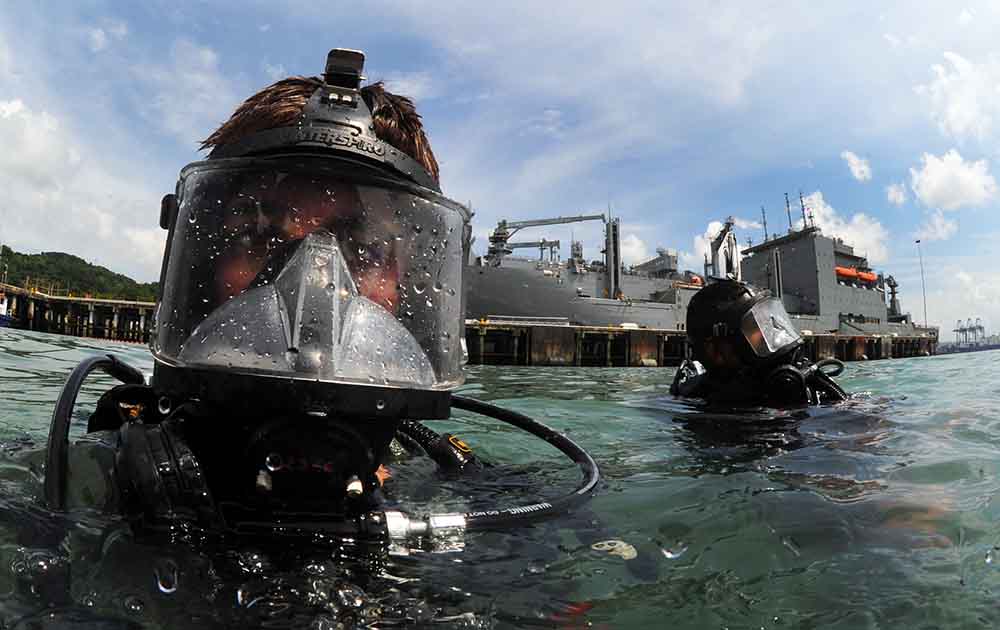
Many large commercial ports and harbours now have IDS systems deployed at key entrance points to protect visiting ships. However, why not consider fitting systems like our own Sentinel IDS to the vessel itself so that it remains protected wherever it goes? On tankers in service, how practical is that? Well, easier and quicker than you may think, as one of our original design aims for Sentinel was to protect ships.
Retrofitting an intruder detection sonar into an oil and gas tanker
There are several ways to deploy a Sentinel system from a tanker and each has its own merits. First, a quick and temporary solution to protect the vessel when it is at anchor, offshore, would be to overboard the sonar using a simple davit and free suspend the sonar by its cable several metres under the vessel.
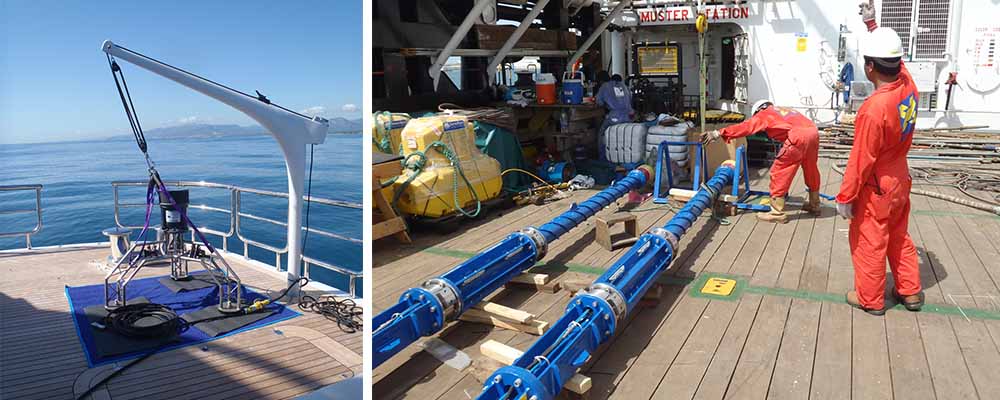
Second, a more permanent and optimal solution is to attach a vertical rail or through-tube support to the side of the vessel. These deployment systems would need to be fitted when the vessel is docked in port and would need welding to the ship’s hull. On a large, tall tanker, this will involve welding several sections together to the side of the vessel to guide the sonar from deck level down into the water below the hull, again several metres below the sea surface, to provide 360-degree coverage.
With any of these deployment arrangements, at any time the vessel is stationary, the sonar can be deployed and switched on in minutes to monitor for divers, swimmer delivery vehicles or unmanned systems that might be nearby.
The reliable detection of underwater intruders – and discrimination from marine fauna – is a notoriously difficult problem. But, our Sentinel system can detect threats hundreds of metres away – and even tells you what the threat is. In the real world, performance like this buys you time; time to consider the most effective response to the emerging threat. This could be requesting support from nearby naval forces, deploying your own security team to intercept the threat, or getting the vessel underway and simply moving away from danger.
Fitting an intruder detection sonar into a new vessel
Of course, the best approach is to consider your vessel’s security at the start of the design process rather than when it’s already entered service – devoting as much consideration as you would to say the choice of engines or bridge layout.
When fitting an IDS into a new vessel, the most discrete method – and the one that will deliver best performance – is to install it on a hydraulic pole that’s lowered and raised through the hull at the touch of a button.
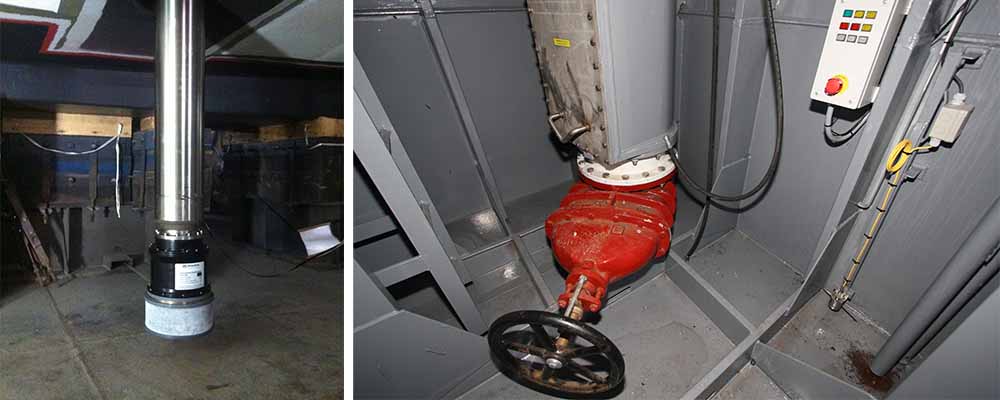
These are usually sited well away from sources of noise interference, such as azimuth thrusters and depth sounders – all of which have the potential to limit a sonar’s ability to detect threats at the maximum achievable range. We’ve a lot of experience installing acoustic and sonar instrument deployment machines on hundreds of vessels over more than forty years, with designs available that can be adapted to meet the requirements of installation through double hulls and in hazardous, eg. ATEX certified, areas.
How many sonars are required?
Smaller oil and gas tankers can be protected with a single sonar, ideally deployed as close to the centre of the vessel as possible. For larger vessels, for example the Suez-Max-class, a sonar close to the bow and another close to the stern would create an overlap to improve classification and tracking.
I mentioned at the start above-water security sensors such as CCTV and radar. Sentinel’s designed to work standalone, or in sync with these technologies. We regularly work with leading providers of maritime security systems including MarineGuard and MARSS to integrate Sentinel with bridge-based security systems for use on large private yachts, naval patrol vessels, cruise ships and commercial vessels.
The process begins with a phone call or an email to us. It is possible to do a lot of the planning based on a simple desk study, if PDF copies of general arrangement drawings of the vessel can be provided. This can allow a quick understanding of what is possible and the costs. Alternatively, a visit to your vessel would allow us to better understand your operational requirements and recommend the most economical option to close the gap in your tanker’s security. Get in touch today to learn more.
Underwater intruder detection technology from maritime security specialist Sonardyne International Ltd. has been chosen to secure the coastal perimeter of a critical national energy infrastructure (CNI) facility in Eastern Europe.
The Sentinel Intruder Detection Sonar (IDS) will be deployed to detect unauthorised divers and subsurface vehicles approaching the facility from the water. The installation, at an undisclosed location, is the first phase of a site-wide project led by MARSS Group to enhance security at the facility with their NiDAR long-range air, land and underwater situational awareness system.
Sentinel is the most widely deployed commercial off-the-shelf (COTS) underwater intruder detection sonar technology on the market, with a proven ability to discriminate between genuine targets and non-threats, such as large fish or pleasure craft in a wide range of operational environments.
Suitable for fixed, temporary and vessel installation, Sentinel detects, tracks and classifies underwater threats at up to 1.5 km range to provide a rapidly deployable perimeter intrusion capability to help safeguard commercial harbours, naval vessels, private yachts, and waterside residences, as well as critical national infrastructure.
Reliably detecting underwater intruders or vehicles in real-time at long range is essential to provide ample time for security personnel to react to waterborne incursions. Vital minutes can make the difference between successful threat interception and divers and vehicles being able to deliver their attack.
[blockquote author=” Rob Balloch, VP of Sales at MARSS”]”This is our latest project with the team at Sonardyne to incorporate Sentinel into one of our NiDAR surveillance installations. Designed specifically for ease of use by security personnel and to meet the practical requirements of everyday use, for our client, Sentinel was the only IDS that fully met their needs.”[/blockquote]
Ioseba Tena, Global Business Manager at Sonardyne said, “The recent attacks on oil tankers at sea, once again highlights the relative ease with which waterborne attacks can be carried out on strategic energy assets and facilities. With more than 150 installations worldwide, Sentinel’s track record speaks for itself and we’re confident that the level of protection the combined NiDAR-Sentinel solution will deliver the surveillance capability needed to safeguard this important facility.”
